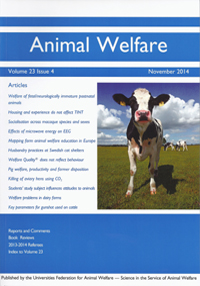Document type: online pre-publication of scientific article in Animal Welfare
Authors: L. Friedrich, J. Krieter, N. Kemper, I. Czycholl
Preview: The aim of this study was to assess the interobserver reliability of the measures forming the Welfare Quality® animal welfare assessment protocol for sows and piglets. The study was carried out at nine farms in Northern Germany. Two trained observers evaluated identical animals simultaneously but independently in 40 joint farm visits. Interobserver reliability was calculated at individual animal level using Cohen's kappa, weighted kappa and the prevalence-adjusted, bias-adjusted kappa (PABAK) and at farm level using Spearman's rank correlation coefficient (RS), the intraclass correlation coefficient (ICC), minimum detectable change (SDC) and limits of agreement (LoA). While a direct comparison of the adjectives of the qualitative behaviour assessment showed poor interobserver reliability, a Principal Component Analysis detected good interobserver reliability. The assessment of social and exploratory behaviours showed acceptable interobserver reliability, while the assessment of stereotypies displayed good interobserver reliability. The Human-animal relationshipsshipsship test showed only poor interobserver reliability at individual animal and farm levels. In most cases, measures of health and physical state assessed in sows and piglets exhibited acceptable or good interobserver reliability. In conclusion, after some measures are revised, particularly those examining the Human-animal relationshipsshipsship, the Welfare Quality® protocol for sows and piglets will represent a reliable approach in terms of interobserver reliability to assess the welfare of sows and piglets.




